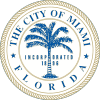Greater Downtown Miami
Downtown Miami | |
|---|---|
 Downtown Miami skyline in 2019 | |
| Nicknames: Downtown, Central Business District | |
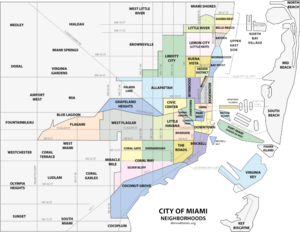 Downtown neighborhoods within the City ofMiami | |
| Coordinates:25°46′26″N80°11′24″W/ 25.774°N 80.190°W | |
| Country | United States |
| State | Florida |
| County | Miami-Dade County |
| City | Miami |
| Settled | 1830s |
| Incorporated into the City of Miami | 1896 |
| Subdistricts of Downtown | |
| Government | |
| • City of Miami Commissioner | Ken Russell (D) |
| • Miami-Dade Commissioners | Vacant |
| •House of Representatives | Luis R. Garcia, Jr.(D) andCynthia A. Stafford(D) |
| •State Senate | Gwen Margolis(D),Dwight Bullard(D), and Miguel Díaz de la Portilla (R) |
| •U.S. House | Maria Elvira Salazar(R) |
| Area | |
| • All Downtown neighborhoods | 3.80 sq mi (9.84 km2) |
| Population (2010)[2] | |
| • All Downtown neighborhoods | 66,769 |
| • Density | 17,570/sq mi (6,780/km2) |
| • CBD population only[3] | 13,856 |
| • Daytime population[3] | 250,757 |
| Demonym | Downtowner |
| Time zone | UTC-05(EST) |
| ZIP Code | 33128, 33129, 33130, 33131, 33132, 33136 |
| Area code(s) | 305, 786 |
| Website | www |
Downtown Miamiis the urbancity centerofMiami,Florida,United States. The city's greater downtown region consists of theCentral Business District,Brickell,theHistoric District,Government Center,theArts & Entertainment District,andPark West.It is divided by theMiami Riverand is bordered byMidtown Miami'sEdgewater,andWynwoodsections to its north,Biscayne Bayto its east, theHealth DistrictandOvertownto its west, andCoconut Groveto its south.
Downtown Miami is the core of theMiami metropolitan area,thenation's ninth-largestand world's34th-largest metropolitan areawith a population of 6.158 million people.
Within Downtown Miami,Brickell Avenueand Biscayne Boulevard are the main north–south roads, andFlagler Streetis the main east–west road. The Downtown Miami perimeters are defined by the Miami Downtown Development Authority as the 3.8-square-mile (9.8 km2) area east ofInterstate 95betweenRickenbacker Causewayto the south and theJulia Tuttle Causeway,which connects Miami andMiami Beach,to the north.
The area is a cultural, financial, and commercial center of the Miami metropolitan area, tracing its present-day history back to the 19th century. In recent years, Downtown Miami has thethird greatest concentrationofhigh-risesin the United States and is home to many major museums, parks, education centers, banks, company headquarters, courthouses, government offices, theaters, shops and many of the oldest buildings in the city.
History
[edit]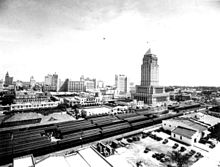
Downtown Miami is the historic heart ofMiami.Along withCoconut Grove,Downtown Miami is the oldest settled area of Miami, with earlypioneersettlement dating to the early 19th century. Urban development began in the 1890s with the construction of theFlorida East Coast RailwaybyStandard OilindustrialistHenry Flaglerdown to Miami at the insistence ofJulia Tuttle.Flagler, along with developers such asWilliam BrickellandGeorge E. Merrickhelped bring developer interest to the city with the construction of hotels, resorts, homes, and the extension of Flagler's rail line.Flagler Street,originating in Downtown, is a major east–west road in Miami named after the tycoon; theJulia Tuttle Causeway,crossingBiscayne Bayjust north of Downtown inEdgewater,is named in honor of Tuttle.
As of 2009, there are approximately 71,000 year-round residents in Greater Downtown (including Downtown'sBrickell,Park West,andArts & Entertainment Districtneighborhoods), with close to 200,000 populating the Downtown area during the daytime, making Downtown Miami one of the most populousdowntownsin the U.S. afterNew York CityandChicago.[4]With recent mass construction of high-rise residential buildings and office towers, Downtown has experienced large growth, with new shops, bars, parks, and restaurants opening up, attracting many new residents.
Along with Brickell, Downtown has grown from 40,000 residents in 2000, to over 70,000 in 2009, making it one of the fastest-growing areas in Florida. It was estimated in February 2010, that about 550 new residents move to the Downtown area every month.[5]As of 2009, over 190,000 office employees work in Downtown and Brickell.[6]
Downtown is served by theMiami MetrorailatHistoric Overtown/Lyric Theatre,Government Center,andBrickellstations, accessible fromBrowardandPalm Beachcounties viaTri-Rail transfer station.The Metro connects to the DowntownMetromover,which encompasses 22 stations on the clockwise Inner (or Downtown) loop and counterclockwise Brickell and Omni branch loops. Government Center station is Downtown's main station and allows for transfers to all Metromover loops, Metrorail trains, and Metrobus lines at theStephen P. Clark Government Center.
Neighborhoods
[edit]Downtown Miami is centered on theCentral Business District(CBD), best known by locals as simply "Downtown". Although distinct neighborhoods with different characters, all the following neighborhoods are often labeled under theumbrella termof "Downtown Miami":
Central business district ( "downtown" )
[edit]
TheCentral Business District(CBD), often referred to locally as simply "Downtown", is the historic center of Miami. The CBD is bound by Northeast Sixth Street to the north,Biscayne Bayto the east, and theMiami Riverto the west and south. The majority of Miami's historic buildings are located in this district, includingFlagler Street,museums, libraries, offices, schools, the vast majority of local, county, state and federal government offices and courthouses, and Miami'sHistoric DistrictandGovernment Center.
The CBD is directly served by theMiami MetrorailatGovernment Center Stationand by 13Metromoverstations on the Downtown, Brickell, and Omni Loops.
Miami Jewelry District
[edit]TheMiami Jewelry Districtis a sub-neighborhood within the Central Business District historically known for its numerous jewelry stores,jewelersand gem dealers. It is where a variety ofjeweled productsare sold and is one of the three jewelry districts in the United States.[7]It comprises four city blocks, bounded by NorthMiami Avenue,Northeast Second Avenue, EastFlagler Streetand Northeast Second Streets. Shoppers can find designer jewelry,precious stones,andgoldand silver items at street level in various retail jewelry stores. The Jewelry District can be accessed by public transportation through theMetromoverandMetrorail.
Brickell
[edit]Brickellis south of the Miami River, and is a mixed upper-class residential neighborhood as well as Miami's majorfinancial districtalongBrickell Avenue.The Shops at Mary Brickell Village,Brickell City Center, and Simpson Park are located within Brickell. Brickell is directly served by theMiami MetrorailatBrickell Station,and by fiveMetromoverstations on the Brickell Loop.
Arts and Entertainment District
[edit]TheArts & Entertainment Districtis an urban neighborhood with numerous hotels, and high-rise residential buildings. The neighborhood's former nameOmnicomes from theOmni International MallonBiscayne Boulevard.The district bordersBiscayne Baythe east, NE 2nd Ave to the west, NE 21st St to the north andI-395to the south. Pace Park,Adrienne Arsht Center for the Performing Arts,and the (former)Miami Heraldheadquarters are located within the district. The Arts & Entertainment District is served by theMiami Metrorailat:Government Center Station,and by twoMetromoverstations on the Omni Loop.
Park West
[edit]Park West is the neighborhood just west ofMuseum Park,east of NW 1st Ave, south ofI-195,and north of NE 6th St. Park West was primarily known for itsnightclubs,and in recent years has been the talk of much revitalization and project proposals for the revitalization of the area. By the end of 2015 most of the nightclubs along the former club row west of the MetroMover from the Freedom Tower station to the Eleventh Street Station have been demolished to make way for planned construction ofMiami World Center.[8] Park West is directly served by theMiami Metrorailat:Historic Overtown/Lyric Theatre Station,and by threeMetromoverstations on the Omni Loop.
Demographics
[edit]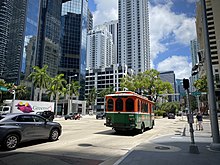
| Census | Pop. | Note | %± |
|---|---|---|---|
| 1990 | 36,140 | — | |
| 2000 | 40,556 | 12.2% | |
| 2010 | 66,769 | 64.6% | |
| 2020 | 110,006 | 64.8% | |
| 2022 (est.) | 113,649 | 3.3% | |
| source:[10] | |||
As of 2010, the population of Downtown Miami was 65,696 people, with a population density of 27,487 per square mile. In the 2010 US Census, the racial makeup of Downtown was 57.6%Hispanicof any race, 30.8%White (non-Hispanic),7.2%Black,and 2.9%Asian.[9]The zip codes for Brickell include 33129, 33130, and 33131. The area covers 1.084 square miles (2.81 km2).
In 2000, Downtown had a population of 39,176 residents, with 15,333 households in 1990 with an average of 2.2 residents per household, 17,130 households in 2000 with a household average of 2.1, and 33,600 households in 2009 with a household average of 2.0 residents. By 2014, the population of Downtown is expected to grow to 85,000 with 42,400 households. The median household income was $29,396 in 2000 and $40,180 in 2009.[11]
The zip codes for Downtown include 33128, 33130, 33131, and 33132. The area covers 2.117 square miles (5.48 km2). As of 2000, there were 6,451 males and 4,792 females. The median age for males were 34.5 years old, while the median age for females were 35.8 years old. The average household size had 1.9 people, while the average family size had 2.8 members. The percentage of married-couple families among all households was 25.5%, while the percentage of married-couple families with children (among all households) was 8.5%, and the percentage of single-mother households among all households was 5.8%. 15.3% of the population was in correctional institutions. 1.6% of the population was in other group homes. The percentage of never-married males 15 years old and over was 27.6%, while the percentage of never-married females 15 years old and over was 13.9%.[12]
As of 2000, the percentage of people that speak English not well or not at all made up 23.1% of the population. The percentage of residents born in Florida was 26.9%, the percentage of people born in another U.S. state was 25.0%, and the percentage of native residents but born outside the U.S. was 6.4%, while the percentage of foreign born residents was 41.7%.[12]
2009 Census projections indicate that the area's residential base has increased from 40,000 to 71,000 since 2000, with an expected Downtown population of 85,000 by 2014. As of 2006, 189,164 residents live in the immediate Downtown/Brickell area.[5][13]
Transportation
[edit]Public transportation in the Downtown area is used more than in any other part of Miami and is a vital part of Downtown life.Metrorail,Miami'sheavy railsystem, makes three stops in Downtown on both the green and orange lines at theHistoric Overtown/Lyric Theatre Station,Government Center Station,and theBrickell Station.In addition to Metrorail, theautomatedMetromovertrain system runs three lines (the Downtown Loop, the Omni Loop, and the Brickell Loop) with 22 stations throughout Downtown. The Metromover is a free service and stations can be found at roughly every two blocks in Downtown and Brickell.
Downtown Miami is served byMetrobusthroughout the area, theMiami Metrorail,and theMetromover:
Metrorail:
- Government Center(NW 1st Street and 1st Avenue)
- Brickell(SW 11th Street and 1st Avenue)
- Historic Overtown/Lyric Theatre(NW 8th Street and 1st Avenue)
Metromover:
- Downtown/Inner Loop
- Omni Loop
- Brickell Loop
Metrorail has stops throughout Miami with connections toMiami International Airport,all Metrobus lines,Tri-RailandAmtrak.The main bus station in Downtown is located next to the Arsht Center at theAdrienne Arsht Center Station.
As an urban andpedestrian-friendlyarea with an extensivepublic transitnetwork, Downtown (along withBrickell,theArts & Entertainment District,andSouth Beach) is one of the areas in Miami where a car-free lifestyle is commonplace. Many Downtown residents get around by foot, bicycle,Metromoveror by taxi. The Metromover is a popular alternative to walking in the area, especially on rainy, hot or cold days, as the Metromover is free, and stations are located roughly every two blocks throughout the area.
Recently, the City of Miami, along with the Downtown Development Authority, has begun bicycle initiatives promoting citywide bike parking andbike lanes,that have made bicycling much more popular for residents.Bike lanesandbike sharrowsare currently planned for the majority of Downtown streets to be painted by the end of 2010.Venetian Causewayis a popularbicycle commuterroute that connectsSouth Beachto Downtown. TheRickenbacker Causewayis very popular on weekends for recreational bicyclists, and often, bicycles can outnumber cars on the causeway.[14]
Tri-Rail expansion
[edit]In the 2025 and 2030 long range transportation plans, Miami'scommuter railsystem,Tri-Rail,has envisioned moving to or adding service on theFlorida East Coast Railway(FEC) corridor, which runs along the region's densest neighborhoods, parallel toBiscayne Boulevardin Miami, and Federal Highway in Broward and Palm Beach counties.
Tri-Rail service on the FEC line would bring Tri-Rail to Downtown's transit hub,Government Center Station,connecting Downtown directly toMidtown Miami/Miami Design District,Upper East Side/Miami Shores,North Miami,North Miami Beach/Aventura,DowntownHollywood,and DowntownFort Lauderdale.Currently, rail commuters must transfer onto theMetrorailinHialeahto get to Downtown. Miami's Downtown Development Authority along with Miami-area politicians are actively lobbying to bring Tri-Rail to the city core.[15]
Taxis
[edit]Taxis are popular in Downtown, especially from Downtown toSouth Beach,Design Districtor toCoconut Grove.Since many Downtown residents choose to not have cars, taxis are also popular for rides within Downtown neighborhoods, especially after midnight when theMetromoverstops running. Taxis can be hailed on the street, or phoned.
Economy
[edit]
Downtown is home to many companies, corporations and organizations. Downtown has about 20 million square feet (1,900,000 m2) of office space, and is the central financial and business hub ofSouth Florida.[16]Some private companies with headquarters in Downtown areAkerman LLP,Arquitectonica,Espírito Santo Financial Group,Florida Justice Institute,Greenberg Traurig,Holland & Knight,Macy's Florida,Miami Herald,Miami Today,Shutts & Bowen,Terremark Worldwide,Vector Group,World Property Channel, and Zyscovich Architects.[17]Sanford Group Company and Sanford Fiduciary Investor Services, Inc., andLTU Internationalhad headquarters in Downtown.[18][19]
Public organizations with their main offices in Downtown include, the central offices of the Beacon Council, the Downtown Development Authority,Miami-Dade County government,Miami-Dade County Public Schools,Miami Police Department,Miami-Dade Parks and Recreation], and other City of Miami departments despitecity hall's location inCoconut Grove.
Consulates
[edit]Several countries haveconsulatesbased in Downtown, most of which are located alongBiscayne BoulevardandBrickell Avenue.These include:
 Argentina[20]
Argentina[20] Bahamas[21]
Bahamas[21] Bolivia
Bolivia Brazil[22]
Brazil[22] Chile[23]
Chile[23] Colombia[24]
Colombia[24] Dominican Republic[25]
Dominican Republic[25] Ecuador[26]
Ecuador[26] France[27]
France[27] Germany[28]
Germany[28] Guatemala[29]
Guatemala[29] Haiti[30]
Haiti[30] Israel(Consulate-General of Israel to Florida & Puerto Rico)[31]
Israel(Consulate-General of Israel to Florida & Puerto Rico)[31] Jamaica[32]
Jamaica[32] Japan[33]
Japan[33] Mexico
Mexico Netherlands[34]
Netherlands[34] Paraguay[35]
Paraguay[35] Peru[36]
Peru[36] Spain
Spain Suriname
Suriname Turkey
Turkey Trinidad and Tobago[37]
Trinidad and Tobago[37] United Kingdom[38]
United Kingdom[38] Uruguay
Uruguay
Japan first opened its consulate in Miami in 1992. As of 1992 this consulate gives logistical support to Japanese embassies in the Caribbean and Latin America. Japan opened a consulate in Miami after Japanese investors purchased several major real estate properties in Florida.[39]
Chambers of commerce
[edit]Downtown is also home to many internationalchambers of commerce,these include:
- British American Business Council
- Italy-America Chamber of Commerce
- Spain-United States Chamber of Commerce
- German American Business Chamber
- Chilean-American Chamber of Commerce
- French American Chamber of Commerce.
Historic districts
[edit]
Downtown has threeU.S.historic districts.The Downtown Miami Commercial Historic District, the Downtown Miami Historic District, and the Lummus Park Historic District.[40]
TheDowntown Miami Historic Districtcomprises 380 acres (1.5 km2) in the heart of Downtown with over 60 buildings within its jurisdiction. Many of the buildings within the area are of theModernestyle andClassical Revivalstyle with uses for government, residential, and commercial. Periods of significance within this area are from 1900 to 1924, 1925 to 1949, and 1950 to 1974. The Downtown Miami Commercial Historic District was designated a historic district in 1988 and comprises 20 buildings on the east side of Downtown with 19th and early 20th-century revival styles.
TheLummus Park Historic Districtis west of Downtown in the neighborhood of Lummus Park. It is west ofI-95surroundingLummus Parkalong theMiami River.The historic district was designated historic in 1988 and then expanded in 2006. The area is 260 acres (1.1 km2) large with 43 different buildings mostly owned by private entities and the local government. Prominent styles include late 19th and early 20th-century revival styles,Art Deco,andBungalowstyle, with prominent periods of 1900–1924 and 1925–1949.
Parks
[edit]
Downtown's largest and most popular parks areBayfront Park,Museum Park,and Pace Park. Bayfront Park is host to the free DWTWN Concert Series, put on weekly in the park's amphitheater, as well as various other annual events such as the Orange Drop for New Year's, Bike Miami, and the "America's Birthday Bash at Bayfront Park" for Independence Day. Bayfront Park hosts many large outdoor concerts such asWarped TourandUltra Music Festival.Formerly Bicentennial Park, Museum Park has been redone, and is now the site for new buildings for theMiami Art Museumand theMiami Science Museum.
Other parks in the Downtown area include:
- Fort Dallas Park,Central Business District
- Lummus Park,Central Business District
- Paul S. Walker Park, Central Business District
- Joan Lehman Sculpture Plaza, Central Business District
- Robert F. Clark Plaza, Central Business District
- Southside Park, Brickell
- Simpson Park,Brickell
- Alice Wainwright Park,Brickell
- Brickell Park, Brickell
- Miami Circle, Brickell
- Brickell Key Park, Brickell
- Brickell Plaza Mini Park, Brickell
Government and infrastructure
[edit]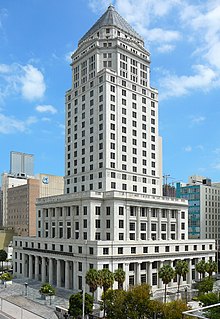
As thecounty seatof Miami-Dade County, Downtown is home to the central offices and departments of theMiami-Dade Countygovernment, mainly located in theGovernment Centerarea. TheStephen P. Clark Government Centeris the central headquarters of Miami-Dade government with the offices of the Miami-Dade Mayor. Although city hall for the City of Miami is inCoconut Grove,many offices of Miami's city government are in Downtown, including the city's Planning Department. TheMiami Police Departmentalso has its central offices in Downtown.[41]
Downtown is home to many city, county, state, and federal courthouses, jails, judge offices, and law firms. Some of the courthouses in Downtown are the Dade County Family Court, U.S. Court of Appeals Judge, U.S. District Court Clerk,[42]Miami-Dade County Courthouse,[43]Federal Courthouse, U.S. Magistrate Judge, City of Miami courthouses and many others.[44]
TheUnited States Postal Serviceoperates two post offices in Downtown. They are the Brickell Post Office and the Flagler Miami Post Office.[45][46]TheFederal Detention Center, Miami,operated by theFederal Bureau of Prisons,is located in Downtown.[47]
Fire stations
[edit]TheCity of Miami Fire and Rescue Departmentoperates 4 of its 14 fire stations within the Downtown area. Each are listed below.
- Fire Station # 1 – 144 NE 5th Street – Midtown/Overtown (Downtown)
- Fire Station # 2 – 1901 N Miami Avenue – Wynwood/Edgewater
- Fire Station # 3 – 1103 NW 7th Street – Little Havana/Overtown
- Fire Station # 4 – 1105 SW 2nd Avenue – Brickell/The Roads (Downtown)
Cost of living
[edit]The average apartment sale price was $347,729 in 2010, up 15% from 2009, with the average apartment price at $300 per square foot. During theMiami building boomof the first decade of the 21st century, 23,628condominiumandapartmentswere built[48]in numerous high-rise towers that quickly transformed the city. Over 85% of these apartments are now occupied as of early 2011. It is estimated that about 550 new residents move to Downtown every month.[49]Renters make up 56% of the residents in Downtown.[50]
In July 2011, Downtown's office vacancy rate was reported at 21% dropping from a high of 26% in mid-2010. Downtown also reported an average commercial asking rate of $36.33, making it the eighth-highest in the nation afterManhattan,Washington DC,Fairfield County, Connecticut,San Francisco,andBoston.[51]
Downtown has over 6,000 hotel rooms in numerous hotels. Downtown has Miami's largest concentration of hotel rooms, and is the city's hub forbusiness travellers.Many of these hotels are geared for business travellers, mostly alongBrickell Avenue,some for luxury leisure stays, and others as bargain tourist hotels.
Retail
[edit]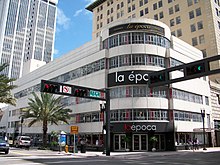
Historically,Flagler Streethas been Downtown's major shopping street dating back to the 19th century. Today, it is still Downtown's major shopping street, with Florida's flagshipMacy's(formerlyBurdines) on Flagler Street andMiami Avenuefrom 1912 to 2018, as well as Miami's own local department stores: La Época, on Flagler and SE 2nd Av; Alberto Cortes, on Flagler and SE 3rd Av. Flagler Street is also home to many well-known and establishedjewelers,many of whom have been in Downtown since the early 20th century (i.e.: Morays Jewelers, founded in 1900). This area is called theMiami Jewelry Districtand comprises four Downtown blocks from Miami Avenue to SE 2nd Av on Flagler Street and NE 1st St.
After many years of decay, recently, much focus has been placed on revitalizing Flagler Street to its former grandeur. In recent years, a renewed investment interest has been placed on Flagler Street, and many new restaurants and stores have opened up, new landscaping and pavers have been placed, as well as enforced security and tourist guides. Three newpocket parksopened on Flagler St in 2009, Paul S. Walker Park, Robert F. Clark Plaza, and the Joan Lehman Sculpture Plaza. These new parks have brought more green space, benches, art, and rest areas to the street.
Besides Flagler Street, Downtown has two other major shopping areas,Bayside MarketplaceandMary Brickell VillageinBrickell.Bayside Marketplace was built in 1987, and is one of Miami's most visited tourist attractions averaging over 15 million visitors a year. It is an outdoor shopping mall overlookingBiscayne BayatBayfront Park.Bayside Marketplace has many national retail chains, as well as local Miami stores. Mary Brickell Village is on Miami Avenue and SE 10th Street in Brickell. Mary Brickell Village is a major nightlife area and has many of Miami's upscale bars and restaurants that stretch along Miami Avenue from around SE 6th Street to Broadway (SE 15th Road).
Education
[edit]Public schools
[edit]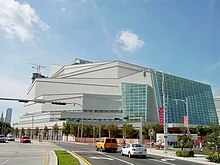

Miami-Dade County Public Schoolsoperates Downtown Miami's public schools, which include:
Elementary schools
[edit]- Downtown Miami Charter School
- Southside Elementary School
- Miami Children's Museum School
- Bridgepoint Academy of Greater Miami (Charter)
High schools
[edit]- Law Enforcement Officers' Memorial High School,a magnet school
- New World School of the Arts,an arts magnet school
Public school zoning
[edit]Downtown children are zoned based on the neighborhood they live in within Downtown, roughly split into Brickell, Central Business District (CBD), and Arts & Entertainment District/Edgewater.[53]
- Elementary schools:
- Southside Elementary School, for Brickell children
- Riverside Elementary School, for CBD children
- Frederick Douglass Elementary School, for CBD children
- Phillis Wheatley Elementary School, for Arts & Entertainment District and Edgewater children
- Middle schools:
- Shenandoah Middle School, for Brickell children
- José de Diego Middle School, for CBD, Arts & Entertainment District and Edgewater children
- High schools (open to all Downtown residents):
- Young Women's Preparatory School, all-girls
- Young Men's Preparatory School, all-boys
- Booker T. Washington High School
Private schools
[edit]Plans are currently underway for a 1,700-studentpreparatory schoolin Brickell at 1742 SW 2nd Avenue, named "Brickell Preparatory Academy". Other private schools in Downtown are:
- First Presbyterian International Christian School
- Gordon Day School (Jewish)
- Prima Casa Montessori School
Colleges and universities
[edit]- Florida International University(Downtown Center), a public university at 1101 Brickell Avenue
- Miami Dade College(Wolfson Campus), a public college
- Miami International University of Art & Design,a private university
- Miami Culinary Institute,a public college
- University of Miami,highly ranked private research university in neighboringCoral Gables
Cultural institutions
[edit]
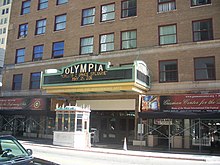

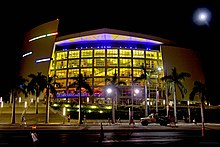
Museums and historic sites
[edit]- Pérez Art Museum Miami
- Historical Museum of Southern Florida
- Miami Children's Museum
- Wagner Home
- Freedom Tower
- City of Miami Cemetery
- Downtown Miami Historic District
- Lummus Park Historic District
- Miami Circle
Theatres and performance arts
[edit]- Adrienne Arsht Center for the Performing Arts
- Ziff Ballet Opera House
- Knight Concert Hall
- Florida Grand Opera
- Gusman Center for the Performing Arts
- Miami City Ballet
- Miami Wind Symphony
Libraries
[edit]Places of worship
[edit]
- Central Baptist Church(Built in 1925)
- First Church of Christ Scientist(1925)
- First Presbyterian Church(1898)
- First United Methodist Church(1966)
- Gesu Catholic Church(1896)
- Greater Bethel AME Church(1927)
- Miami Central SpanishSeventh-day Adventist Church(Miami, Florida) (1925)
- St. Jude Catholic Church(1946)
- Temple Israel of Greater Miami(1926)
- Trinity Episcopal Cathedral(1925)
- Immanuel Lutheran Church
- Temple Israel of Greater Miami
- Central Korean Presbyterian Church
- The Shul of Downtown and Brickell
Bookstores
[edit]- Books and Books – Wachovia Financial Center
- Miami Book Fair International,an annualliterary festivalheld atMiami Dade College
Festivals and events
[edit]- DWNTWN Concert Series, free performances every 2nd Friday of the month at 5:30pm,Bayfront Park
- New Year's Big Orange Drop,Bayfront Park
- Miami Marathon,marathonheld in January
- Ultra Music Festival,electronic musicfestival held in March
- Miami International Film Festival,held in March
- Winter Music Conference,held in March
- Independence Day Celebration,Bayfront Park
- Miami Book Fair International,literary festivalheld in November
- Art Basel Miami,art exhibitionheld in December
- Miami International Boat Show
- The Arts Of Storytelling, held in March
- The Best of the Best Reggae Concert
Sports facilities
[edit]- American Airlines Arena,home of theMiami Heat
Downtown skyscrapers
[edit]
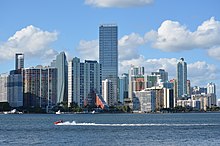
Office towers
[edit]- Four Seasons Hotel Miami
- Southeast Financial Center
- Miami Tower
- One Biscayne Tower
- 1450 Brickell
- 701 Brickell Avenue
- Brickell Financial Centre
- Brickell Arch
- Sabadell Financial Center
- Brickell Bay Office Tower
- Latitude One
- SunTrust International Center
- Alfred I. DuPont Building
- Miami Center
- Courthouse Center
- Museum Tower
- Dade County Courthouse
- New World Tower
- Stephen P. Clark Government Center
- Met 2 (Wells Fargo Center)
Residential towers
[edit]Hotel towers
[edit]See also
[edit]References
[edit]- ^"2016; Greater Downtown Miami Demographics"(PDF).miamidda.Applied Research and Analytics.RetrievedMarch 12,2020.
- ^"2016; Greater Downtown Miami Demographics"(PDF).miamidda.Applied Research and Analytics.RetrievedMarch 12,2020.
- ^ab"Archived copy"(PDF).Archived fromthe original(PDF)on October 24, 2018.RetrievedOctober 24,2018.
{{cite web}}:CS1 maint: archived copy as title (link) - ^"Miami Downtown".Archived fromthe originalon December 15, 2014.RetrievedNovember 28,2014.
- ^abhttp:// cpnfromtheinside /2009/07/study-confirms-downtown-miami-is-coming-to-life.html.RetrievedJuly 27,2009.
{{cite web}}:Missing or empty|title=(help)[dead link] - ^Miami Heraldhttp:// miamiherald /103/story/1030124.html.RetrievedMay 4,2009.
{{cite web}}:Missing or empty|title=(help)[dead link] - ^"Biscayne Boulevard Improvements".Archived fromthe originalon August 9, 2014.RetrievedMarch 20,2011.
- ^"Miami Worldcenter".miamiworldcenter.
- ^ab"Mapping the 2010 U.S. Census".The New York Times.December 13, 2010.
- ^"Total Population".U.S. Census.RetrievedJune 7,2024.
- ^"Archived copy"(PDF).Archived fromthe original(PDF)on March 20, 2012.RetrievedJuly 15,2011.
{{cite web}}:CS1 maint: archived copy as title (link) - ^ab"Demographics of Downtown, Miami, FL".city-data.RetrievedAugust 31,2009.
- ^http:// miamidda /business-demographics.html.RetrievedJune 13,2008.
{{cite web}}:Missing or empty|title=(help)[dead link] - ^Do bicyclists and pedestrians outnumber cars on the Rickenbacker Causeway on weekend mornings? | Transit MiamiArchivedJanuary 6, 2011, at theWayback Machine
- ^Miami Downtown Development Authority hashing out plans to bring Tri-Rail downtown
- ^Miami Downtown Development AuthorityArchivedJuly 13, 2011, at theWayback Machine.Miamidda. Retrieved on 2013-08-16.
- ^"Vector Group Ltd".vectorgroupltd.
- ^"Contact Us."LTU International.March 3, 2000. Retrieved on June 21, 2009.
- ^"Company Directory."Stanford Financial Group. July 8, 2000. Retrieved on June 21, 2009.
- ^"ContactenosArchived2009-02-03 at theWayback Machine."Consulate-General of Argentina in Miami.Retrieved on January 30, 2009.
- ^"Contact & Overseas MissionsArchived2009-02-16 at theWayback Machine."Ministry of Foreign Affairs (The Bahamas).Retrieved on January 31, 2009.
- ^"The Consulate."Consulate-General of Brazil in Miami.Retrieved on January 30, 2009.
- ^"Oficinas Consulares en Estados Unidos."
- ^"- Consulado de Colombia en Miami".miami.consulado.gov.co.
- ^"Welcome to the website of the Consulate General of the Dominican Republic in Miami.",Consulate-General of the Dominican Republic in Miami.Retrieved on January 31, 2009.
- ^"Other Consulates in the USAArchivedFebruary 5, 2009, at theWayback Machine."Embassy of Ecuador in Washington, DC.Retrieved on January 30, 2009.
- ^"AddressArchivedJuly 18, 2011, at theWayback Machine."Consulate-General of France in Miami.Retrieved on January 30, 2009.
- ^"Address, Contact and Office HoursArchivedJanuary 6, 2009, at theWayback Machine."Consulate-General of Germany in Miami.Retrieved on January 30, 2009.
- ^"Consular OfficesArchivedMay 16, 2009, at theWayback Machine."Consulate-General of Guatemala in Denver.Retrieved on January 31, 2009.
- ^"Diplomatic and Consular MissionsArchived2009-02-21 at theWayback Machine."Embassy of Haiti in Washington, DC.Retrieved on January 30, 2009.
- ^"Consulate-General of Israel to Florida & Puerto Rico." Israel Diplomatic Network.Retrieved on January 30, 2009.
- ^"ContactArchivedMay 27, 2013, at theWayback Machine." Consulate-General of Jamaica in Miami.Retrieved on January 30, 2009.
- ^"Contact." Consulate-General of Japan in Miami.Retrieved on January 30, 2009.
- ^Home page. Consulate-General of Netherlands in Miami.Retrieved on January 30, 2009.
- ^"El ConsuladoRetrieved on January 30, 2009.
- ^"Datos GeneralesArchivedJanuary 10, 2009, at theWayback Machine
- ^"Consulate General of the Republic of Trinidad and Tobago MiamiArchived2011-05-12 at theWayback Machine."Retrieved on May 18, 2011
- ^"MiamiArchived2009-02-21 at theWayback Machine."UK in USA.Retrieved on January 30, 2009.
- ^"JAPAN OPENS CONSULATE TO SERVE SOUTH FLORIDA."Miami Herald.January 10, 1992. 1C Business. Retrieved on January 17, 2012.
- ^"National Register of Historical Places - FLORIDA (FL), Dade County".nationalregisterofhistoricplaces.
- ^Miami Police Department.Miami-police.org. Retrieved on 2013-08-16.
- ^Miami-Dade County - Clerk of Courts.Miami-dadeclerk (May 29, 2013). Retrieved on 2013-08-16.
- ^"Dade County Courthouse MapArchived2010-03-15 at theWayback Machine."Miami-Dade County.Retrieved on March 12, 2010.
- ^U.S. Marshals Service, Courthouse Locations.Usmarshals.gov (June 3, 2004). Retrieved on 2013-08-16.
- ^"Post Office Location - BRICKELL."U.S. Postal Service.Retrieved on December 30, 2009.
- ^"Post Office Location - FLAGLER MIAMIArchived2012-07-16 atarchive.today."U.S. Postal Service.Retrieved on December 30, 2009.
- ^"FDC Miami Contact InformationArchivedOctober 16, 2012, at theWayback Machine."Federal Bureau of Prisons.Retrieved on December 30, 2009.
- ^"DDA Report: Downtown Miami Condos Rise in Sales, Price and Absorption".Pordes Residential. March 2, 2011.RetrievedNovember 20,2015.
- ^"Archived copy"(PDF).Archived fromthe original(PDF)on May 16, 2011.RetrievedFebruary 26,2011.
{{cite web}}:CS1 maint: archived copy as title (link) - ^Patel, Julie."An insurance option worth considering".
- ^U.S. Office Market Records Largest Quarterly Decline in Vacancy Rates Since Mid-2007; Miami Posts Strongest Vacancy Drop - WORLD PROPERTY CHANNEL Global News CenterArchivedMarch 18, 2012, at theWayback Machine.Worldpropertychannel. Retrieved on 2013-08-16.
- ^Freedom Tower in Miami - Guide to Miami's Freedom TowerArchivedOctober 1, 2011, at theWayback Machine.Miami.travelape (April 24, 2009). Retrieved on 2013-08-16.
- ^Services Near YouArchivedJuly 19, 2011, at theWayback Machine




